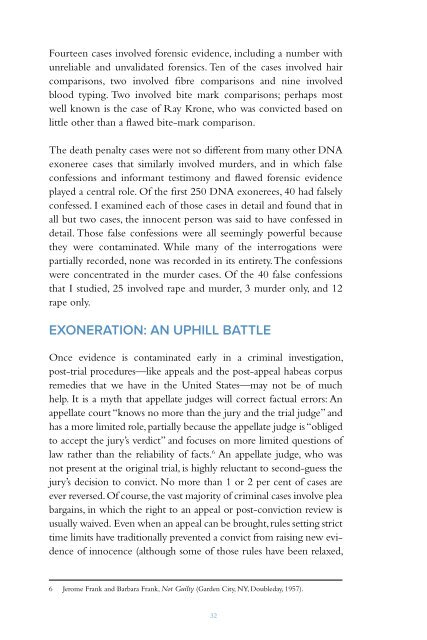PENALTY
DBk0302s7Xm
DBk0302s7Xm
You also want an ePaper? Increase the reach of your titles
YUMPU automatically turns print PDFs into web optimized ePapers that Google loves.
Fourteen cases involved forensic evidence, including a number with<br />
unreliable and unvalidated forensics. Ten of the cases involved hair<br />
comparisons, two involved fibre comparisons and nine involved<br />
blood typing. Two involved bite mark comparisons; perhaps most<br />
well known is the case of Ray Krone, who was convicted based on<br />
little other than a flawed bite-mark comparison.<br />
The death penalty cases were not so different from many other DNA<br />
exoneree cases that similarly involved murders, and in which false<br />
confessions and informant testimony and flawed forensic evidence<br />
played a central role. Of the first 250 DNA exonerees, 40 had falsely<br />
confessed. I examined each of those cases in detail and found that in<br />
all but two cases, the innocent person was said to have confessed in<br />
detail. Those false confessions were all seemingly powerful because<br />
they were contaminated. While many of the interrogations were<br />
partially recorded, none was recorded in its entirety. The confessions<br />
were concentrated in the murder cases. Of the 40 false confessions<br />
that I studied, 25 involved rape and murder, 3 murder only, and 12<br />
rape only.<br />
EXONERATION: AN UPHILL BATTLE<br />
Once evidence is contaminated early in a criminal investigation,<br />
post-trial procedures—like appeals and the post-appeal habeas corpus<br />
remedies that we have in the United States—may not be of much<br />
help. It is a myth that appellate judges will correct factual errors: An<br />
appellate court “knows no more than the jury and the trial judge” and<br />
has a more limited role, partially because the appellate judge is “obliged<br />
to accept the jury’s verdict” and focuses on more limited questions of<br />
law rather than the reliability of facts. 6 An appellate judge, who was<br />
not present at the original trial, is highly reluctant to second-guess the<br />
jury’s decision to convict. No more than 1 or 2 per cent of cases are<br />
ever reversed. Of course, the vast majority of criminal cases involve plea<br />
bargains, in which the right to an appeal or post-conviction review is<br />
usually waived. Even when an appeal can be brought, rules setting strict<br />
time limits have traditionally prevented a convict from raising new evidence<br />
of innocence (although some of those rules have been relaxed,<br />
6 Jerome Frank and Barbara Frank, Not Guilty (Garden City, NY, Doubleday, 1957).<br />
particularly by state statutes that permit post-conviction DNA testing),<br />
and claims of innocence remain very difficult to make.<br />
Once the appeal is over, an indigent inmate lacks the constitutional right<br />
to a state-provided attorney. Every jurisdiction in the United States offers<br />
some type of review after the appeal is complete, usually called post-conviction<br />
or habeas review. This additional level of review may permit, in<br />
theory, litigation of claims that could not have been raised during the<br />
initial appeal. However, non-death-row inmates typically do not have<br />
lawyers to help them navigate the incredibly complex procedural barriers<br />
that limit the chances of success during such reviews.<br />
The death-row DNA exonerees typically followed a long road from<br />
trial to exoneration. Four of them had two trials; two had three trials.<br />
Each time they were convicted again, until they finally obtained DNA<br />
testing and were exonerated. The picture was not much different for the<br />
full group of DNA exonerees, including those who were not sentenced<br />
to death, except that among the non-death-row prisoners, even fewer<br />
received any relief prior to obtaining DNA testing. Non-death-row<br />
exonerees often did not obtain lawyers after their appeal and could not<br />
get any help filing habeas petitions. They rarely challenged the faulty<br />
evidence that caused their wrongful convictions, and when they did try,<br />
they failed. The figure that follows illustrates the degree to which the<br />
first 250 DNA exonerees (those who had judges write decisions in their<br />
cases) tried to challenge the evidence presented at their trials during<br />
appeal or post-conviction review, and how few obtained conviction<br />
reversals before they were successfully exonerated using DNA testing.<br />
Post-conviction challenges to evidence by the<br />
first 250 DNA exonerees<br />
We now know that these people were innocent, but they did not have<br />
any luck raising claims of innocence either: Every DNA exoneree who<br />
tried to raise such a claim failed. These appeals and post-conviction<br />
challenges took time; the road to exoneration took an average of 15<br />
years. Of the 18 death-row DNA exonerees, 8 earned reversals on<br />
appeal or post-conviction. This high reversal rate is consistent with<br />
other studies of post-conviction litigation by death row inmates,<br />
although these cases were mostly litigated before the passage of the<br />
32 33


